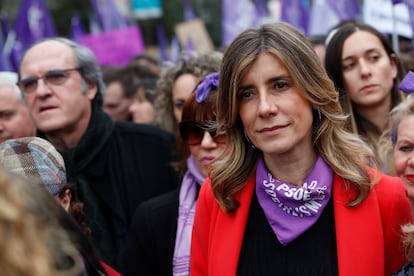Wife of Spanish Prime Minister Pedro Sánchez tests positive for the coronavirus
There was also controversy on Saturday when Deputy Prime Minister Pablo Iglesias attended a Cabinet meeting, despite his partner being infected

Begoña Gómez, the wife of Spanish Prime Minister Pedro Sánchez, has tested positive for the coronavirus. From La Moncloa prime ministerial palace, sources said yesterday that she is “following prevention measures established by the health authorities.”
The same sources said that the “tests carried out in recent hours on the people closest to the prime minister have come back positive in the case of his wife, Mrs Begoña Gómez. Both Mrs Gómez and the prime minister are well, both are in La Moncloa and at all times are following the prevention measures set out by the health authorities.”
Begoña Gómez and Irene Montero were present at a march in Madrid for International Women’s Day last Sunday.
Tests earlier in the week confirmed that the minister for territorial policy, Carolina Darias, and the equality minister, Irene Montero, had also contracted the SARS-CoV-2 virus. “Both are in their homes and in a good condition,” La Moncloa sources stated on Saturday night.
Begoña Gómez and Irene Montero were present at a march in Madrid for International Women’s Day last Sunday. The Spanish government has been widely criticized by the opposition for letting the demonstrations go ahead across Spain, given that the coronavirus was already spreading fast through the Spanish population at that point. Just the next day, the Madrid regional authorities opted to close all schools, meaning 1.5 million students in the region would not be going to class.

There was also controversy on Saturday when Irene Montero’s partner, Pablo Iglesias, who is the leader of their Unidas Podemos party, attended a marathon Cabinet meeting, at which the state of alarm was debated and eventually put into place. Iglesias, who is one of Spain’s deputy prime ministers in the Socialist Party-Unidas Podemos coalition government, had stated that he would remain in quarantine in his home from Thursday onward given the positive diagnosis of his partner.
However, Iglesias tested negative for the coronavirus and sat to the left of Pedro Sánchez during Saturday’s meeting. He was roundly criticized on social media for not staying in quarantine, in particular by opposition politicians such as far-fight Vox party leader Santiago Abascal, who has also contracted the coronavirus and is in quarantine in his home.
“I have been in a nine-square-meter room without leaving for the last few days, and all of my family is at home and in contact with me respecting the quarantine,” Abascal wrote. “And I see that the deputy prime minister is not respecting his own quarantine by going to the Cabinet meeting where they will ban us from leaving the house. Political caste.”
Sources from Unidas Podemos explained on Saturday that Iglesias was aware that his decision to go to the Cabinet meeting lacked coherence, but that it was impossible to participate in the meeting by video link. He did so, the same sources said, to defend the position of his party on an issue of utmost importance and in which the “protection of thousands of workers in the country was at play.”
Also via Twitter, Pablo Iglesias claimed that “the prime minister called me to attend the Cabinet meeting in person because legally the video conference option could not be put into place.”
Government sources told reporters on Saturday that the meeting to agree on the state of alarm measures took so long due to disagreements between the government partners, in particular with Unidas Podemos pushing for greater financial support for workers who will be affected by the total lockdown that has been imposed across Spain.
English version by Simon Hunter.
Tu suscripción se está usando en otro dispositivo
¿Quieres añadir otro usuario a tu suscripción?
Si continúas leyendo en este dispositivo, no se podrá leer en el otro.
FlechaTu suscripción se está usando en otro dispositivo y solo puedes acceder a EL PAÍS desde un dispositivo a la vez.
Si quieres compartir tu cuenta, cambia tu suscripción a la modalidad Premium, así podrás añadir otro usuario. Cada uno accederá con su propia cuenta de email, lo que os permitirá personalizar vuestra experiencia en EL PAÍS.
¿Tienes una suscripción de empresa? Accede aquí para contratar más cuentas.
En el caso de no saber quién está usando tu cuenta, te recomendamos cambiar tu contraseña aquí.
Si decides continuar compartiendo tu cuenta, este mensaje se mostrará en tu dispositivo y en el de la otra persona que está usando tu cuenta de forma indefinida, afectando a tu experiencia de lectura. Puedes consultar aquí los términos y condiciones de la suscripción digital.
Últimas noticias
Most viewed
- Alain Aspect, Nobel laureate in physics: ‘Einstein was so smart that he would have had to recognize quantum entanglement’
- David King, chemist: ‘There are scientists studying how to cool the planet; nobody should stop these experiments from happening’
- Maps of the US attack on Venezuela: Targets, airspace and deployed fleet
- Key points of the military attack on Venezuela: Early morning bombings and a ‘captured’ president
- World reactions to the US strikes on Venezuela








































